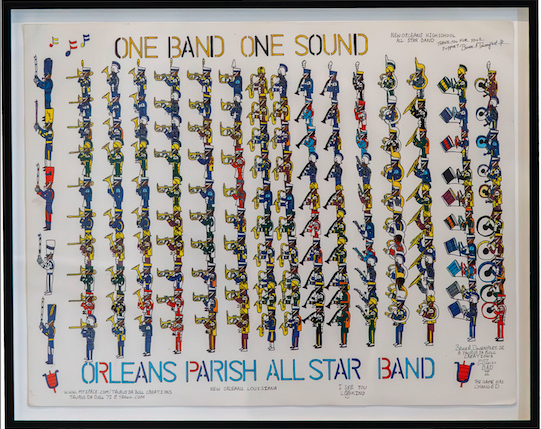"Lifelike" is All About Context

The new show at the New Orleans Museum of Art needs to be seen in its space to be fully appreciated.
The subtext of "Lifelike," the new show at the New Orleans Museum of Art, is the art gallery experience. The collected pieces not only rely on the gallery to make them seem special, but they need that context to prompt the right questions.
The show features works that trick the eye into believing the unreal is real, or in some cases, that the real is unreal. A sheet of plywood by John Clem Clark is actually a large canvas meticulously painted to resemble plywood. One installation of photos surround the viewer with scenes from New York City, or more accurately, a New York City set on a Hollywood back lot. A plaid shopping bag by Susan Collis has a plaid pattern that is entirely hand-drawn, and a white garbage bag was actually carved marble to look like an overstuffed trash bag.
By themselves, they're cool oddities - like so much magic and illusion, parlor tricks on an epic scale. Take a couple of Andy Warhol's Brillo boxes outside of NOMA and set them by the curb and they'd only be noteworthy to those who wonder, "Do they still make Brillo?" Inside the gallery, the pieces gain life. If you discovered Keith Edmier's installation "Bremen Towne" while house hunting, you'd think it was a small kitchen in desperate need of renovation; in NOMA, a host of questions are raised by his meticulous recreation of the kitchen of the house he grew up in in suburban Illinois circa 1971. Why do this? How was it done? Is it art? Is this real? What does "real" mean?
It was, in fact, a far more labor-intensive task than it seems at first. What looks like an exercise in shopping involved numerous art activities, including the effort to recreate the wallpaper and flooring, which he hand-yellowed and distressed. When Edmier first showed the kitchen, it was part of a recreation of a number of rooms, not just the kitchen and for me, it's hard to imagine more of the house being more effective than this presentation. Visitors walk from a gallery space into the cramped kitchen, which draws attention to the low ceiling and cramped quarters. Edmier's task may have been to reexamine the world that shaped him by recreating it, but walking into "Bremen Towne" also invites contemplation of suburban claustrophobia.
Ai Weiwei's "Ku Hua Zi (Sunflower Seeds)" is similarly unprepossessing on the surface. The jar of sunflower seeds is actually the product of a town in China that is known for its fine porcelain. The seeds are made of porcelain and each was hand painted. When the piece was in production, it became part of the life of town as most of its denizens were involved in its creation at some level. There's a political dimension to the piece that we likely miss - that Chairman Mao was often depicted with or amid sunflowers in Chinese political posters - but in New Orleans, there's a resonance that likely doesn't exist in other cities. Since most Mardi Gras beads are made China, we're invited to consider the relationship between these porcelain sunflower seeds and the beads we catch, and the notion of beads as the livelihood of a community, the things that pay the bills if not give people's lives meaning.
"Ku Hua Zi (Sunflower Seeds)" has a deadpan sense of humor, like much of "Lifelike." Some pieces play more obviously for chuckles, such as Maurizio Cattelan's miniature working elevator doors and Robert Therrien's oversized card table and accompanying chairs. The latter were shipped to NOMA folded as they would be at regular size, the table with the legs folded underneath. But many play with ironic juxtapositions. "Nomad" is Gavin Turk's cast brass sculpture of a homeless person zipped inside a blue sleeping bag, and "Forever Young" by Susan Collis uses ebony, oxidized silver, white gold and other precious materials to resemble a pile of busted-up trash.
If nothing else, "Lifelike" is the show for those who go to a gallery, look at abstract paintings and say, "I could do that." They can't do these pieces. The works are meticulously crafted, labor intensive and often require a variety of mechanical talents, not just painting and sculpting. "Rain/Regen" by Thomas Demand is a video installation of rain hitting a sidewalk that requires animation and sound engineering expertise since it is, as as you'd expect in this show, a recreation of rain on the sidewalk, with frying eggs standing in for the sound of the droplets hitting the pavement.
Even though the works on display require remarkable craft, "Lifelike" is a profoundly conceptual show that dramatizes core questions about the nature of art. That this conversation is taking place at NOMA speaks to place the museum has chosen for itself in the New Orleans art community.






